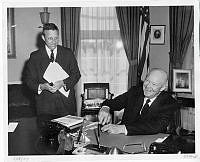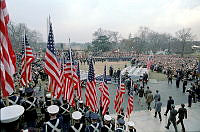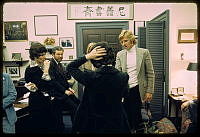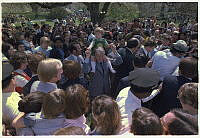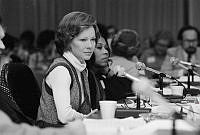Rubenstein Center Scholarship
Secret Service and the Presidents
Gallery
-

A plainclothes guard at the White House east gate during the Civil War.
Library of Congress -

A White House policeman standing at the North Entrance of the White House, c. 1890.
Library of Congress -

Secret Service Chief John Wilkie in his office, c. 1910.
Library of Congress -

U.S. Secret Service agents Edmund Starling (left, directly behind First Lady Grace Coolidge) and James "Jim" Haley (right, behind President Calvin Coolidge) as they leave Congregational Church in Washington, D.C.
Library of Congress, National Photo Collection -

A military guard directs pedestrian traffic away from the Northwest entrance of the White House during World War II.
D.C. Public Library -

Military guards march outside the White House gates during World War II.
D.C. Public Library -

The White House Police Force was created in 1922, placed under the supervision of the Secret Service in 1930, and later renamed the Executive Protective Service in 1970. It was renamed the Secret Service Uniformed Division in 1977. President Barack Obama addresses officers before a group photo at the South Portico of the White House, 2011.
Official White House Photo by Pete Souza -

A U.S. Secret Service agent prepares to open the door to the Oval Office for President Barack Obama in 2009.
Official White House Photo by Pete Souza
Historian William Seale has described presidential protection as a learning process, with presidents and their families and the Secret Service sometimes straining to adjust to one another.
Although from the beginning guards were posted at the White House gates and front doors and the White House grounds were patrolled by a day guard and a night watchmen, it was not until 1842 that the first permanent security force for the White House was established—an auxiliary guard of a captain and three other men. The proposal to create the force had met opposition in Congress; Sen. John J. Crittenden of Kentucky warned “it might be metamorphosed into a political guard for the executive … it would not be entirely safe to organize such a corps. It was a little sort of stand guard, which might eventually become a formidable army.”1
Crittenden’s fears went unrealized, and in 1853 Franklin Pierce became the first president to have a full-time bodyguard, and also introduced the two-level security arrangement that characterizes presidential protection today. A guarded outer perimeter securing the Executive Mansion itself, and an inner perimeter—the bodyguard to protect the person of the president.
During the Civil War there were heightened security fears in Washington that Confederates just across the Potomac in Virginia could easily slip across and attack President Abraham Lincoln at the White House. Metropolitan Police guarded the Executive Mansion but Lincoln did not want the house to take on the characteristics of an armed camp. Guards inside the Mansion (the doormen) dressed in civilian clothes and concealed their firearms. Uniformed, armed sentries were posted at the gates to the grounds and at the doors to the Executive Mansion itself.
During the Theodore Roosevelt administration (1901-1909), the Secret Service assumed full-time responsibility for protecting the President. President Roosevelt was guarded by at least two Secret Service men. Roosevelt chafed under the safeguard. “He did not like restraint,” one observer recalled. “Always free and active in his manner of life, he found the vigilance of the secret service men irksome and their constant presence irritating.” To frustration of his Secret Service detail, Roosevelt would sometimes secretly slip off the White House grounds and go for an invigorating hike or horseback ride in Rock Creek Park.2
His successor, William Howard Taft, followed the same mischievous tradition. At 4:30 on Christmas Eve afternoon 1911, the president and first lady secretly left the White House on foot in a rainstorm to call on friends as a surprise. When the Secret Service discovered their absence, there was widespread panic. Chief John Wilkie and his men scurried all over town searching for them. Two hours after their departure a soaked and dripping first couple returned to the White House, smiling broadly.3
Edmund W. Starling, who would become chief of the White House Secret Service detail in the 1920s, frequently saw presidents in unguarded moments. When the widowed President Woodrow Wilson was courting the widowed Mrs. Edith Galt, he would often walk back from her home on 20th Street to the White House with Starling. The agent found it difficult to believe the president was 58 years old, for “We walked briskly, and the president danced off the curbs and up them when we crossed streets.”4
Starling was a particular favorite of President Calvin Coolidge, who often tried to outwit his protector. “Sometimes … he would try to sneak out the East or the West entrance, just to fool me. … One day I turned the tables on him and hid in the police box on the East side. He came out of the engine room, up the East steps, and passed right by me. I fell into position behind him. When he reached the gate he turned around with a look of glee on his face. ‘Good morning, Mr. President,’ I said. He turned and headed for F Street without saying a word.”5
Following the United States’ entry into World War II, the Secret Service changed the White House grounds forever, banning casual visitors and setting up sentry boxes manned by agents and members of the White House police force. “No more throngs of Congressional constituents being escorted along the beautiful, stately grand corridor … from the East Room to the State Dining Room,” the first lady’s good friend Lorena Hickok remembered, “No more government clerks hurrying through the grounds … in the late afternoon on their way home from work … No more Sunday tourists feeding the squirrels, taking snapshots and hanging around the portico hoping someone interesting would come out.”6
President Franklin Roosevelt objected to security plans by the Secret Service and the military to cover the White House skylights, paint the White House in camouflage, place machine gun turrets on the roof, or to build barricades or station a group of tanks around the mansion, feeling that the public would be alarmed unnecessarily. The first lady shared some of the president’s irritation with the safety measures. “Mrs. Roosevelt is very much annoyed today with Secret Service …” her personal secretary Malvina “Tommy” Thompson noted nine days after Pearl Harbor, “because they insisted she could not have 350 foreign students in the White House for tea. … In exasperation, Mrs. Roosevelt asked if they were going to take down the Washington monument because an enemy could measure the distance between it and the White House.”7
Since World War II the degree of Secret Service protection for the president and family has increased significantly, and the relationship can be, as President Harry S. Truman’s daughter Margaret wrote in 1972, “often hectic, but never unfriendly.” The Secret Service agents guarding her and her parents, she concluded, were “probably the finest, most dedicated group … I have ever met.”8














